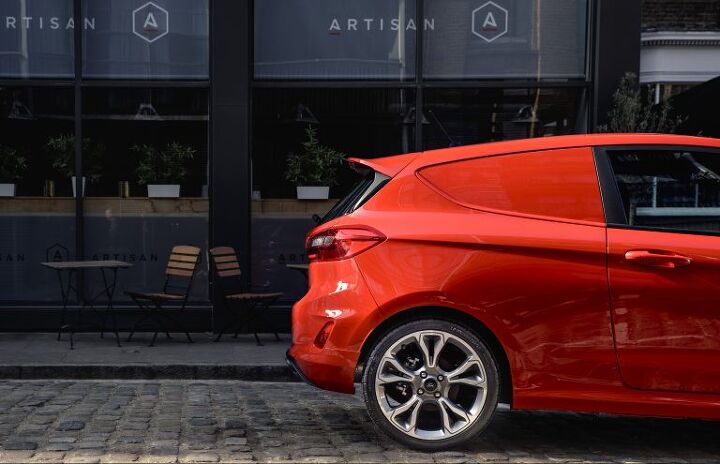Ford Presents Endearing Little Fiesta Sports Van

We’re always surprised with what counts as a van in Europe. For example, Ford just showcased a new one based on the Fiesta at the Birmingham Commercial Vehicle Show — and it’s kind of wonderful. However, we’re unlikely to see it on our roads. A vehicle like this makes almost no sense for the North American market.
In fact, I can only think of a handful of applications for such an automobile: high-volume pizza delivery, flower delivery, amateur plumber, organ transport, and pet grooming for a business that only takes modestly sized animals. But they would all have to take place in an extremely-dense urban environment to rationalize the use of such a small vehicle. Otherwise, business owners are going to splurge on a proper small van like the Transit Connect.
Ford says the load compartment is capable of housing roughly 35.3 cubic feet of cargo with a load length of almost 4.3 feet. Gross payload is around 1102 pounds. The isolated cargo space utilizes a “composite and mesh full bulkhead, durable sidewall trim, and a tough rubber floor covering with four tie-down hooks.”
It’s all very practical and has been designed to be especially durable, and tailored especially to businesses with the inclusion of a speed limiter and a bunch of connectivity features (FordPass Connect, Wi-Fi hotspot, navigation with live updates). There are also driving aides to help keep employees from adding scratches or dents — parking assist, cross traffic alert, and traffic sign recognition comes standard.
That hasn’t suppressed twisted fantasies where the vehicle is imported into North America for non-business applications. Ford said the durable Fiesta van comes in a sport model, donning 18-inch wheels, sporty seats, plus a unique steering wheel, pedals, gear lever, and exterior details. Remember when everyone was taking basic Honda CRX HFs for next to nothing, stripping them down, and turning them into goofy FWD mischief makers? The Fiesta panel van could be that kind of car, and Ford has already done half the work for you.
Still, it doesn’t come with the most desirable of powertrains. Options include an 85 horsepower 1.1-liter three-banger, a 125 horsepower 1.0-liter turbo, and 1.5-liter diesel making 85 hp that you definitely wouldn’t want for hooliganism. But, in this daydream, you’d be waiting to purchase something used and swapping in a different engine, anyway. You’d also have to hack out a bunch of that rear cargo area… unless that’s where the new engine is going, a la Ford Supervan.
Okay, this fantasy is getting out of hand. It’s just interesting to see a Fiesta with unique styling in a wholly different design from what we’re used to. Realistically, none of these units will ever see anything other than modest payloads and reasonable speeds a full continent away.
Meanwhile, we’re still waiting on Ford to drop the domestic axe on the passenger version of the Fiesta.
[Images: Ford Motor Co.]

A staunch consumer advocate tracking industry trends and regulation. Before joining TTAC, Matt spent a decade working for marketing and research firms based in NYC. Clients included several of the world’s largest automakers, global tire brands, and aftermarket part suppliers. Dissatisfied with the corporate world and resentful of having to wear suits everyday, he pivoted to writing about cars. Since then, that man has become an ardent supporter of the right-to-repair movement, been interviewed on the auto industry by national radio broadcasts, driven more rental cars than anyone ever should, participated in amateur rallying events, and received the requisite minimum training as sanctioned by the SCCA. Handy with a wrench, Matt grew up surrounded by Detroit auto workers and managed to get a pizza delivery job before he was legally eligible. He later found himself driving box trucks through Manhattan, guaranteeing future sympathy for actual truckers. He continues to conduct research pertaining to the automotive sector as an independent contractor and has since moved back to his native Michigan, closer to where the cars are born. A contrarian, Matt claims to prefer understeer — stating that front and all-wheel drive vehicles cater best to his driving style.
More by Matt Posky
Latest Car Reviews
Read moreLatest Product Reviews
Read moreRecent Comments
- SCE to AUX Range only matters if you need more of it - just like towing capacity in trucks.I have a short-range EV and still manage to put 1000 miles/month on it, because the car is perfectly suited to my use case.There is no such thing as one-size-fits all with vehicles.
- Doug brockman There will be many many people living in apartments without dedicated charging facilities in future who will need personal vehicles to get to work and school and for whom mass transit will be an annoying inconvenience
- Jeff Self driving cars are not ready for prime time.
- Lichtronamo Watch as the non-us based automakers shift more production to Mexico in the future.
- 28-Cars-Later " Electrek recently dug around in Tesla’s online parts catalog and found that the windshield costs a whopping $1,900 to replace.To be fair, that’s around what a Mercedes S-Class or Rivian windshield costs, but the Tesla’s glass is unique because of its shape. It’s also worth noting that most insurance plans have glass replacement options that can make the repair a low- or zero-cost issue. "Now I understand why my insurance is so high despite no claims for years and about 7,500 annual miles between three cars.







































Comments
Join the conversation
"There are also driving aides to help keep employees.... traffic sign recognition comes standard." Forgive me for being mistaken, but I THOUGHT that trafic sign recognition was a necessary skill requirement to obtain a driving license AND therefore the responsibility of the DRIVER!
Another market would be musicians who play larger instruments (double bass, tuba, bass saxophone, drums, keyboards). Especially if there are only two front seats and the passenger one can fold down to make a flat floor with the rear floor.